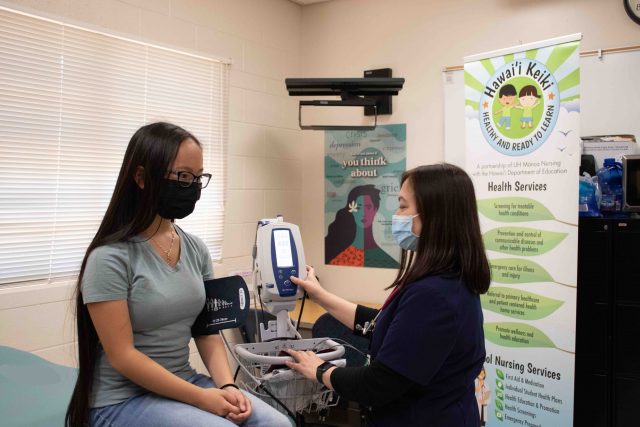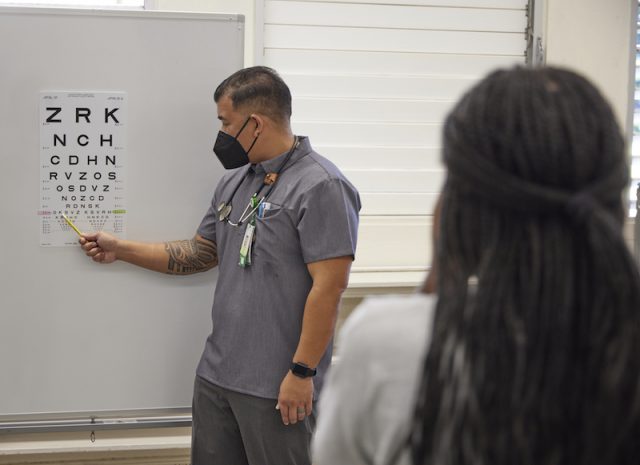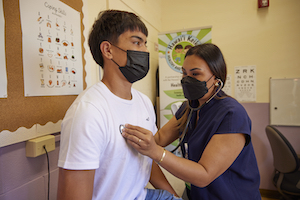Celebrating Hawaii’s school nurses, their critical role on public school campuses
From August 2022 to March 2023, there have been nearly 8,000 health room visits to see a school nurse by Hawaii public school students. On May 10, National School Nurse Day, Hawaii’s public school nurses are recognized for their key roles in helping students, schools and families in many ways.

For nearly a decade, Hawaii Keiki: Healthy and Ready to Learn, a partnership between the University of Hawaii at Manoa School of Nursing & Dental Hygiene and Hawaii Department of Education (HIDOE), has been placing school nurses in public schools to provide no-cost school-based health services to students. Having an in-person presence on campus and seeing the parents and their child face-to-face is critical to getting students the healthcare they need.
Hawaii Keiki Impact (August 2022-March 2023)
- 7,998 health room visits to a Hawaii Keiki nurse by HIDOE students
- 69% of students returned to class instead of being sent home after visiting a Hawaii Keiki nurse
- 151 screening events of 13,408 dental and vision screenings in collaboration with community partners
- 429 telehealth appointments for HIDOE students through Hawaii Keiki Virtual Keiki Care

Adele Mier is a Hawaii Keiki registered nurse who has been based at Nanakuli Elementary School for the past six years.
“For students whose parents and guardians consent to care, we can provide clinic visits, connect students to a Hawaii Keiki nurse practitioner for a virtual appointment, and we do emergency action plans if they come in with a chronic condition already existing or something that was identified during their screening. And beyond the students, we support families and our communities through health education and outreach,” Mier said.
“Providing health screenings to students on-campus is also very important,” she added. “During past health screenings, we identified students with severe eye problems. Subsequently, students were referred and they received treatment early which positively impacted the students and their families.”

Evolved roles from pandemic
During the COVID-19 pandemic, the role of the school nurse rapidly evolved to include the use of telehealth technology to address students’ physical, as well as mental health needs. Mental health concerns for youth have increased after the challenges brought by the pandemic, including remote learning, increased isolation and family stress.
“As school nurses, we talk a lot with students to make sure they are okay emotionally and can provide mental health support and make referrals if needed,” Mier said. “It is nice to know that the program can now connect these students with a Hawaii Keiki mental health nurse practitioner virtually allowing the child to stay in school but also get the necessary assessments and support they need.”
The Hawaii Keiki Program was originally launched in 2014 with four school nurses. With the increased need for school nursing support, the Hawaii Keiki Program now serves 258 schools statewide with 17 nurse practitioners (APRNs), two mental health nurse practitioners and 42 registered nurses. The program’s goal is to increase its health-care services to Hawaii students, especially in underserved, rural, and low-income communities where barriers such as transportation, financial circumstances and a shortage of healthcare professionals impact access to care.
“Thanks to the continual support and close collaboration with the Hawaii Department of Education we’ve been able to impact and serve more students and families throughout the years,” said Hawaii Keiki Senior Practice Director Deborah Mattheus, associate professor of nursing at UH Manoa. “We can’t wait to see where the future of school nursing in our state develops and what we can achieve in providing increased access to health services for our schools and the community at large.”
